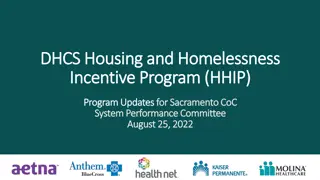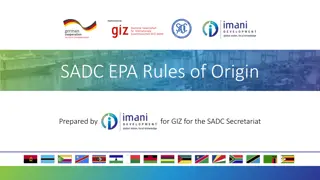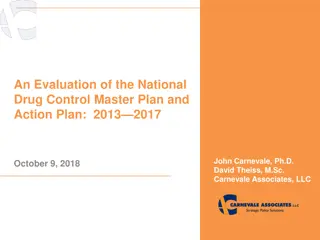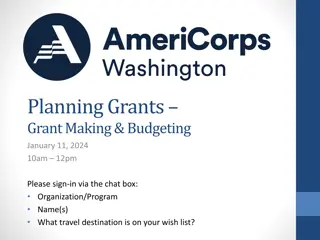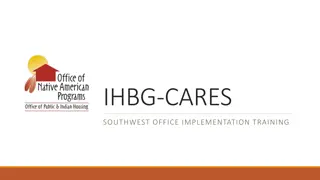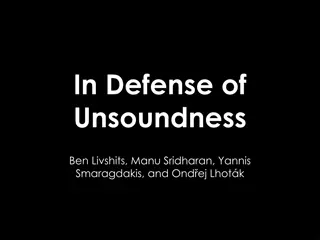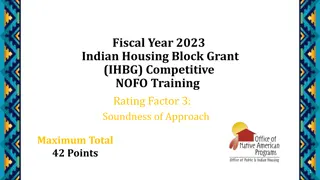IHBG Competitive NOFO Training - Soundness of Approach Subfactor 3.1 Overview
This overview covers Rating Factor 3 - Soundness of Approach, focusing on Subfactor 3.1 of the Indian Housing Block Grant (IHBG) Competitive NOFO. Subfactor 3.1 outlines competitive priorities including New Housing Construction, Housing Rehabilitation, Acquisition of Units, and Affordable Housing-Related Infrastructure projects. Each priority specifies criteria and maximum points available, emphasizing the importance of sound approach in project implementation within the given timeline.
Download Presentation

Please find below an Image/Link to download the presentation.
The content on the website is provided AS IS for your information and personal use only. It may not be sold, licensed, or shared on other websites without obtaining consent from the author.If you encounter any issues during the download, it is possible that the publisher has removed the file from their server.
You are allowed to download the files provided on this website for personal or commercial use, subject to the condition that they are used lawfully. All files are the property of their respective owners.
The content on the website is provided AS IS for your information and personal use only. It may not be sold, licensed, or shared on other websites without obtaining consent from the author.
E N D
Presentation Transcript
FY22 Indian Housing Block Grant (IHBG) Competitive NOFO Training Rating Factor 3: Soundness of Approach 1
Rating Factor 3 Soundness of Approach Maximum total 40 points
Rating Factor Factor Title Points 3
Subfactor 3.1- IHBG Competitive Priorities 4 3.1.a. New Housing Construction Projects 3.1.b. Housing Rehabilitation Projects 3.1.c. Acquisition of Units 3.1.d. Affordable Housing-Related Infrastructure Projects 3.1.e. Other NAHASDA-eligible activities *** Maximum 10 points possible for this Subfactor
Subfactor 3.1- IHBG Competitive Priorities 5 New Housing Construction (NEW): Construct and build new housing units for eligible families. Demolition followed by reconstruction. Acquisition of manufactured housing. Infrastructure associated with (connected to) new housing construction. Acquisition of land associated with (connected to) new housing construction. Will begin within the Period of Performance stated in application. Please view the table for reference on pages 45-46 of the NOFO. Maximum of ten (10) points.
Subfactor 3.1- IHBG Competitive Priorities 6 Housing Rehabilitation (NEW): Improve conditions and structure of existing housing units. Infrastructureassociated with rehabilitation. Acquisition of land associated with rehabilitation. Will begin within the Period of Performance stated in application. Please view the table for reference on page 47of the NOFO. Maximum of seven (7) points.
Subfactor 3.1- IHBG Competitive Priorities 7 Acquisition of Units (NEW): Acquire existing housing units. Increases housing stock. No costs for new construction, rehabilitation, or infrastructure. Infrastructureassociated with(connected to) acquisition of units. Will begin within the Period of Performance stated in application. Please view the table for reference on page 48 of the NOFO. Maximum of seven (7) points.
Subfactor 3.1- IHBG Competitive Priorities 8 Affordable Housing Related Infrastructure (or Land Acquisition) (NEW): Spur (stimulate) construction or rehabilitation. Will support existing affordable housing or development of affordable housing. Activities like new housing construction, rehabilitation of homes, and acquisition of units will be completed in the future. Infrastructure will begin within the Period of Performance stated in application. Please view the table for reference on page 49 of the NOFO. Maximum of seven (7) points.
Subfactor 3.1- IHBG Competitive Priorities 9 Scoring methodology: Step #1: Go to the Cost Summary (HUD-53246) Column B (Planned NAHBG expenditures). Add up all item cost amounts for (each) funding priority (category) to yield the total dollar amount (for each funding priority (category) HUD will calculate the percentage of funding proposed towards the eligible activity (IHBG competitive priority (category)).
Subfactor 3.1- IHBG Competitive Priorities 10 Scoring methodology: Note: HUD will exclude any administration and planning costs in this calculation. HUD will account for direct (project) costs to calculate the percentage dedicate to funding priority (category). Direct (project) costs are costs that dedicated strictly towards specific grant activities. NOTE: The Cost Summary was revised to auto-calculate all direct (project) costs listed. There is a total Direct/Project cost entry incorporated into the form (under Column B).
Subfactor 3.1- IHBG Competitive Priorities 11 Scoring methodology: Direct Costs: Defined as costs identified specifically with a particular final cost objective (2 CFR 200.413). Costs that are going towards a specific purpose (of the project). Hard costs (direct/project) vs. soft costs (indirect/admin) IHBG Competitive Priority (Category) Percentage calculation: Total dollar amount of IHBG Competitive priority funding divided by total direct (project) cost amount. IHBG Competitive funding amount / direct (project) amount. Percentage represent the funding dedicated towards funding activity (IHBG Competitive priority)(project).
Subfactor 3.1- IHBG Competitive Priorities 12 Scoring methodology: Calculation Instructions: Go to Cost Summary, Column B (Planned NAHBG Expenditures) and add up all cost amounts under each IHBG Competitive Priority (Funding Category)(project type) and divide by Total Direct/Project Costs Total Dollar Amount (for each funding priority) / Total Direct/Project Cost amount. Equals percentage of funds dedicated (going toward) the funding priority of the project. Percentage of Funding = Total Dollar Amount of Funding Priority/Total Direct/Project Costs
Subfactor 3.1- IHBG Competitive Priorities 13 Scoring methodology: Step #2: If Multiple activities ->HUD will take the percentage of funding from Step #1 and will determine which Subfactor category (3.1a-3.1e) to apply. HUD will assign points based upon percentage of funding, per IHBG Competitive priority (See points distribution slides). HUD will use the category that will provide the applicant with highest points.
Subfactor 3.1- IHBG Competitive Priorities Scoring methodology (cont.): Acquisition projects with construction, rehab, or infrastructure costs->rate under Subfactor depending on nature of the project proposed Example: Acquisition of manufactured housing would be rated under construction since such housing is constructed before acquisition Acquisition projects without construction, rehab, or infrastructure costs -> rate under 3.1.c. Acquisition of Units
Subfactor 3.1- IHBG Competitive Priorities 15 Scoring methodology (cont.): HUD will apply standard rounding rules. Therefore 74.5% would be rounded to 75% while 74.4% would be rounded to 74%.
Subfactor 3.1- IHBG Competitive Priorities 16 3.1.a. New Housing Construction Projects Point distribution: 100% of funds 80-99% of funds 60-79% of funds 40-59% of funds 4 points Less than 39% Ineligible activity 10 points 8 points 6 points 2 points 0 points
Subfactor 3.1- IHBG Competitive Priorities 3.1.b. Housing Rehabilitation Projects Point distribution: 75-100% of funds 7 points 50- 74% of funds Less than 49% Ineligible activity 0 points 5 points 3 points 17
Subfactor 3.1- IHBG Competitive Priorities 18 3.1.c. Acquisition of Units Point distribution: 75-100% of funds 7 points 50-74% of funds Less than 49% Ineligible activity 0 points 5 points 3 points
Subfactor 3.1- IHBG Competitive Priorities 19 3.1.d. Affordable Housing Related Infrastructure Projects Point distribution: 75-100% of funds 7 points 50-74% of funds 5 points Less than 49% of funds 3 points Ineligible activity 0 points
Subfactor 3.1- IHBG Competitive Priorities 20 3.1.e. Other NAHASDA-eligible activities Point distribution: 100% of funds Ineligible activity Reminder: Model activities under Section 202(6) of NAHASDA are ineligible under this NOFO. 2 points 0 points
Subfactor 3.1- IHBG Competitive Priorities 21 Example #1: Tribe A s Budget Eligible Activity Budgeted Amount (Grant Request) % of Funds Towards Project Subfactor Options (# of Points Awarded) New Housing Construction $4 million 80% Option #1: 3.1a. = 8 points Housing Rehab $1 million 20% Option #2: 3.1.b = 3 points Total Grant Request: $5 million (Direct costs) 100% FINAL Score: Use 3.1a and award 8 points
Subfactor 3.1- IHBG Competitive Priorities Example #2: Tribe B s Budget 22 Eligible Activity Budgeted Amount % of Funds Towards Project Subfactor Options New Housing Construction $2.5 million 50% Option #1: 3.1a. = 4 points Housing Rehab $2.5 million 50% Option #2: 3.1.b = 5 points FINAL Score: Use 3.1b and award 5 points Total Request: $5 million (Direct costs) 100%
Subfactor 3.1- IHBG Competitive Priorities Example #3: Tribe C s Budget Eligible Activity Budgeted Amount $1 million % of Funds Towards Project 22.2% -> 22% Subfactor Options New Housing Construction Housing Rehab Option #1: 3.1a. = 2 points Option #2: 3.1.b = 7 points ----- (not counted) $3.5 million 77.7% -> 78% Admin and Planning $500,000 ----- (not counted) Total: $5 million (Total in Direct costs) $5,000,000-$500,000= $4,500,000 = $4.5 million % based on $4.5 million only FINAL Score: Use 3.1b and award 7 points
Subfactor 3.1- IHBG Competitive Priorities Example #4: Tribe D s Budget Eligible Activity Budgeted Amount New Housing Construction Rehab $2 million 24 % of Funds Towards Project 40% Subfactor Options $2 million Option #1: 3.1a. = 4 points Option #2: 3.1.b = 3 points Option #3: 3.1.c = 3 points N/A: No option for 10% under Subfactor 3.1.e 40% Acquisition $500,000 10% Crime Prevention Activity $500,000 10% Total: $5 million (Direct costs) FINAL Score: 100% Use 3.1a and award 4 points
Subfactor 3.2- Project Implementation Plan (up to 10 points) 25
Subfactor 3.2- Project Implementation Plan 26 Components: 1. Description of how the project is viable and cost- effective 2. Rationale behind the project design 3. Location of the project (e.g. include a map, address and/or aerial photo), site control of location, any zoning compliance requirements, and whether units are on fee- simple or trust land
Subfactor 3.2- Project Implementation Plan 27 Components: 4. Describe how applicant will comply with Indian Preference requirements 5. Infrastructure projects supporting development of affordable housing beyond: a. Describe plans for the housing development project(s) b. Anticipated completion date
Subfactor 3.2- Project Implementation Plan Additional criteria to address: 1. Affordability period (NAHASDA Sec. 205): a. Must establish minimum period for IHBG-eligible families b. Max points for minimum period of at least 20 years 2. Estimated cost savings due to building design, construction methods, or energy efficient measures that will be realized in future years 28
Subfactor 3.2- Project Implementation Plan 29 Additional criteria to address: 3. Size (square feet) and number of units 4. Type of units (e.g. number of bedrooms proposed, single- family vs. multi-family units) Reminder: If applicable, include page references to any specific Workplan Narrative Supporting Attachments!
Subfactor 3.2- Project Implementation Plan 30 Scoring Criteria Points Viable and cost-effective + All components addressed in detail + Affordability period of at least 20 years 10 points Viable and cost effective + Missing description for one component + Affordability period at least 20 years 7 points Viable and cost effective + Missing description for 2-3 components + Affordability period at least 20 years 4 points Not viable and cost-effective or Missing description for 4 or more components+ And/or affordability period less than 20 years 0 points
Subfactor 3.3- Project Implementation Schedule and Project Readiness (up to 10 points) 31
Subfactor 3.3- Project Implementation Schedule and Project Readiness 32 Implementation Schedule (HUD-53247) and Narrative Components: 1. Describe specific tasks and timelines for completing project on time and within budget. Include work of both applicant and any contractors, consultants, sub-recipients, etc. 2. HUD-53247 identify each significant activity and milestones List key milestones Include planned start and completion dates of all tasks 3. Describe if applicant has already completed major steps Environmental review Proposed plans or specifications for new construction or rehab Proposed site for new development Initiation of bid process Secured leveraged financing Coordination efforts with community
Subfactor 3.3- Project Implementation Schedule and Project Readiness 33 4. Identify key milestones that will begin immediately after IHBG Competitive grant award. Describe how you will ensure the project is completed by the Period of Performance end date. Key milestone examples include: 1. Completion of environmental review 2. Developing proposed plans or specifications 3. Proposed site for new development 4. Initiating bid process for procurement 5. Securing leveraged financing (Rating Factor 4) 6. Beginning coordination efforts (Rating Factor 5)
Subfactor 3.3- Project Implementation Schedule and Project Readiness 34 5. Environmental review: Applicant must ensure that no choice limiting actions will occur prior to completion of environmental review and approval of Request for Release of Funds.
Subfactor 3.3- Project Implementation Schedule and Project Readiness 35 5. Environmental review process (cont.): Choice Limiting Action (definition): Action in which a Tribe or TDHE commits or expends HUD or non- HUD funds on activities that reduces or eliminates opportunity to choose alternatives. Changes or alters environment or conditions of land or property of proposed project. Includes actions to acquire, dispose, rehabilitate, demolish, convert, transfer, remove, lease, or construct properties (including entering contracts or other written commitments). NOTE:This is different than the Environmental Review- Expression of Intent application submission requirement listed on p. 23-24 of the NOFO.
Subfactor 3.3- Project Implementation Schedule and Project Readiness 36 Choice limiting actions examples: Real property acquisition; demolition Disposition Rehabilitation New construction Site preparation or clearance Ground disturbance Leasing
Subfactor 3.3- Project Implementation Schedule and Project Readiness 37 Scoring Criteria Points Fully addressed all of the components 10 points Applicant has already completed major steps + Fully address all but one of the components 8 points Applicant has not already completed major steps+ Did not fully address one of the components Did not fully address 2 components regardless of whether applicant has already completed major steps 7 points 4 points Did not fully address 3 or more components regardless of whether applicant has already completed major steps 0 points
Subfactor 3.4-Budget (up to 10 points) 38
Subfactor 3.4- Budget 39 HUD evaluation criteria: 1. 2. 3. 4. Cost Summary (HUD-53246) and budget narrative. Budget thoroughly prepared Costs are eligible under NAHASDA. Costs are allowable, allocable, reasonable, and necessary for implementing the project and activities. Current Total Development Cost (TDC) referenced by 24 CFR 1000.302 and Notice PIH-2022-16 (Updated TDC limits). 5.
Subfactor 3.4-Budget HUD evaluation criteria: Definition overview 1. Eligible = costs are in keeping with NAHASDA Sec. 202. 2. Allowable = costs meet the Cost Principles criteria in 2 CFR 200 Subpart E. Example of unallowable cost: alcohol and entertainment! 3. Allocable = all costs must be tied to the workplan activities and incurred within the Period of Performance, including leveraging Exception: Pre-award proposal costs or land acquisition 4. Reasonable = prudent person test 5. Necessary = Costs crucial for implementing activities
Subfactor 3.4-Budget 41 Budget components: 1. Breakdown of cost estimates by line item for each proposed activity, including administration and planning costs. 2. Budget calculations must be mathematically correct! 3. The SF-424, Cost Summary (HUD-53246), Budget Narrative, and supporting documentation must be consistent .
Subfactor 3.4- Budget 42 Budget components: 4. Determine if costs for housing structures are reasonable. Current Total Development Costs (TDCs), accordance to 24 CFR 1000.302 and Notice PIH-2022-16. Projects meet IHBG regulatory requirements, including TDC requirements. Successful applicants to meet TDC requirement prior to funding (Section B.3.K- Pre-Award Requirements). NOTE: TDCs will not be applicable to projects under Subfactor 3.1.d. Affordable Housing Related Infrastructure Subfactor 3.1.e. Other NAHASDA-eligible activities
Subfactor 3.4- Budget 43 Budget components: 5. Budget Preparation: Describe qualification and experience of individual(s) that prepared the budget pertain to budget preparation. Explain how the experience is recent and relevant to the proposed project.
Subfactor 3.4-Budget Budget components: 44 6. Indirect costs: If applicable, applicants must demonstrate how indirect cost will be calculated in accordance with; Current federally-approved negotiated rate; or De minimis rate (2 CFR 200.414) NOTE: Indirect costs will count toward administration and planning cap. 7. Breakdown of how leveraged resources would be used towards project (if applicable).
Scoring Criteria Points Budget thoroughly prepared + All costs are eligible (under NAHASDA), allowable, allocable, reasonable, necessary + Applicant addressed all components in detail 10 points Budget adequately prepared+ All costs are eligible (under NAHASDA), allowable, allocable, reasonable, necessary+ Applicant addressed some components, but some details were lacking 8 points
Scoring Criteria Points 46 Budget adequately prepared+ All costs are eligible (under NAHASDA), allowable, allocable, reasonable, necessary or, Applicant addressed some components, but some details were lacking (one entire component missing) 6 points Budget adequately prepared+ All costs are eligible (under NAHASDA), allowable, allocable, reasonable, necessary+ Applicant only addressed some components, but some details were lacking Budget not adequately prepared+ Not all cost are eligible (under NAHASDA), allowable, allocable, and necessary 4 points 0 points
End of Rating Factor 3 Module Soundness of Approach 47









